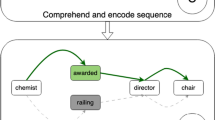Abstract
This study examines the relationship between immediate serial recall and word articulation rate with Cantonese and English materials. Using bilingual subjects, Experiment 1 reported a steeper regression function relating recall to word articulation rate for Cantonese than for English items. The effect of language on regression slopes was shown to hold both with and without concurrent articulation (i.e., subjects repeating irrelevant digits during list learning and recall, thus blocking any articulatory mechanisms), although it was significantly more pronounced in the latter condition. In Experiment 2, the effect of language on slopes was replicated in monolingual English speakers, using pseudowords that preserved the consonant-vowel structures of the Experiment 1 items. These findings indicate that (1) both articulatory and nonarticulatory processes contribute to the cross-language variation in regression slopes and (2) the language effect is attributable to a difference in consonant-vowel structures of the items from the two languages. It is concluded that the phonological loop model (Baddeley, 1986), which specifies an articulatory rehearsal process and a nonarticulatory phonological store, is applicable to cross-language working memory processing.
Similar content being viewed by others
References
BADDELEY, A. D. (1986). Working memory. Oxford: Oxford University Press.
BADDELEY, A. D. (1990). The development of the concept of working memory: Implications and contributions of neuropsychology. In G. Vallar & T. Shallice (Eds.), Neuropsychological impairments of short-term memory. Cambridge, England: Cambridge University Press.
BADDELEY, A. D., & LEWIS, V. J. (1981). Inner active processes in reading: the inner voice, the inner ear and the inner eye. In A. M. Lesgold & C. A. Perfetti (Eds.), Interactive processes in reading. Hillsdale, NJ: Erlbaum.
BADDELEY, A. D., LEWIS, V. J., & VALLAR, G. (1984). Exploring the articulatory loop. Quarterly Journal of Experimental Psychology, 36, 233–252.
BADDELEY, A. D., THOMSON, N., & BUCHANAN, M. (1975). Word length and the structure of short-term memory. Journal of Verbal Learning and Verbal Behavior, 14, 575–589
BESNER, D., & DAVELAAR, E. (1982). Basic processes in reading: Two phonological codes. Canadian Journal of Psychology, 36 (4), 701–711.
CAPLAN, D., & WATERS, G. S. (1994). Articulatory length and phonological similarity in span tasks: A reply to Baddeley and Andrade. The Quarterly Journal of Experimental Psychology, 47A(4, 1055–1062.
CHEUNG, H., & KEMPER, S. (1993). Recall and articulation of English and Chinese words by Chinese-English bilinguals. Memory and Cognition, 21 (5), 666–670.
CHEUNG, H., & KEMPER, S. (1994). Recall and articulation of English and Chinese words under memory preload conditions. Language and Speech, 37(2, 147–161.
CLEMENTS, G. N., & KEYSER, S. J. (1983). Cv phonology: A generative theory of the syllable. Cambridge, MA: Mit Press.
COWAN, N. (1992). Verbal memory span and the timing of spoken recall. Journal of Memory and Language, 31, 668–684.
COWAN, N., DAY, L., SAULTS, J. S., KELLER, T. A., JOHNSON, T., & FLORES, L. (1992). The role of verbal output time in the effects of word length on immediate memory. Journal of Memory and Language, 31, 1–17.
ELLIS, N. C., & HENNELLY, R. A. (1980). A bilingual word-length effect: Implications for intelligence testing and the relative ease of mental calculation in Welsh and English. British Journal of Psychology, 71, 43–51.
FRANCIS, W. N., & KUCERA, H. (1982). Frequency analysis of English usage. Boston: Houghton Mifflin Company.
GUPTA, P., & MACWHINNEY, B. (1995). Is the articulatory loop articulatory or auditory? Reexamining the effects of concurrent articulation on immediate serial recall. Journal of Memory and Language, 34, 63–88.
HANLEY, R. J., & BROADBENT, C. (1987). The effect of unattended speech on serial recall following auditory presentation. British Journal of Psychology, 78, 287–297.
HONG KONG DEPARTMENT OF EDUCATION. (1986). A study of Chinese words used by Hong Kong junior high school students. HK Department of Education.
HOOSAIN, R. (1979). Forward and backward digit span in the languages of the bilingual. The Journal of Genetic Psychology, 135, 263–268.
HOOSAIN, R. (1982). Correlation between pronunciation speed and digit span size. Perceptual and Motor Skill, 55, 1128.
HOOSAIN, R., & SALILI, F. (1987). Language differences in pronunciation speed for numbers, digit span, and mathematical ability. Psychologia, 30, 34–38.
HULME, C., MAUGHAN, S., & BROWN, G. D. A. (1991). Memory for familiar and unfamiliar words: evidence for a long-term memory contribution to shortterm memory span. Journal of Memory and Language, 30, 685–701.
HULME, C., THOMSON, N., MUIR, C., & LAWRENCE, A. (1984). Speech rate and the development of short-term memory span. Journal of Experimental Child Psychology, 38, 241–253.
HYMAN, L. (1975). Phonology: Theory and analysis. New York: Holt, Rinehart, and Winston.
KYNETTE, D., KEMPER, S., NORMAN, S., & CHEUNG, H. (1990). Adults’ word recall and word repetition. Experimental Aging Research, 16(3), 117–121.
LONGONI, A. M., RICHARDSON, J. T. E., & AIELLO, A. (1993). Articulatory rehearsal and phonological storage in working memory. Memory and Cognition, 21 (1), 11–22.
NICOLSON, R. (1981). The relationship between memory span and processing speed. In M. Friedman, J. P. Das, & N. O’connor (Eds.), Intelligence and learning (pp. 179–184). New York: Plenum Press.
SALAME, P., & BADDELEY, A. (1982). Disruption of short-term memory by unattended speech: Implications for the structure of working memory. Journal of Verbal Learning and Verbal Behavior, 21, 150–164.
SCHWEICKERT, R., & BORUFF, B. (1986). Short-term memory capacity: Magic number or magic spell? Journal of Experimental Psychology: Learning, Memory, and Cognition, 12, 419–425.
STANDING, L., BOND, B., SMITH, P., & ISELY, C. (1980). Is the immediate memory span determined by subvocalization rate? British Journal of Psychology, 71, 525–539.
STIGLER, J. W., LEE, S. Y., & STEVENSON, H. W. (1986). Digit memory in Chinese and English: Evidence for a temporally limited store. Cognition, 23, 1–20.
Author information
Authors and Affiliations
Corresponding author
Additional information
We to express our gratitude to Dr. Charles Rice and two anonymous reviewers for their constructive comments on an earlier version of the paper.
Rights and permissions
About this article
Cite this article
Cheung, H., Kemper, S. & Leung, E. A Phonological Account For The Cross-Language Variation In Working Memory Processing. Psychol Rec 50, 373–386 (2000). https://doi.org/10.1007/BF03395361
Published:
Issue Date:
DOI: https://doi.org/10.1007/BF03395361




